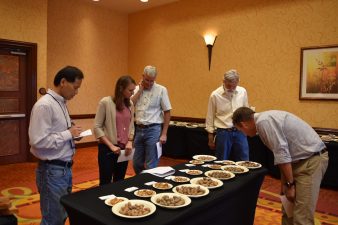
In Search of Texas’ Best Pecans
Being the best at something isn’t taken lightly in Texas. High school football and marching bands. Barbeque and Tex-Mex food.e Youth rodeos and livestock shows. Trophy bucks and large-mouth bass. Beauty pageants and cheer competitions. From the Texas State Fair to the small town festivals around the state, everything from homemade quilts to classic cars...
Read more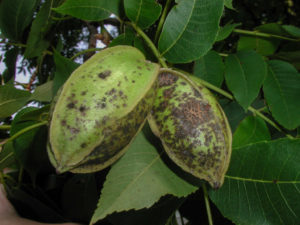
Your fungicide spray program can fight pecan scab and decrease production costs
Here in the southeastern United States, we commonly grow over 20 different pecan cultivars. These vary considerably from each other in any number of ways—size, shape, kernel percentage, shell-out potential, precocity, time of harvest, insect preference, and most notably for this article, pecan scab susceptibility. Since these cultivars vary so widely in their scab susceptibility,...
Read more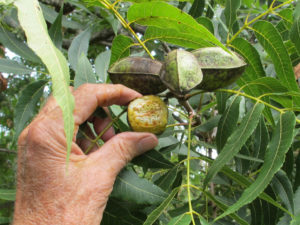
What is Pecan “Super Scab”?
Pecan “super scab” is everywhere from central Texas to the East to the Atlantic Ocean. This foliage and shuck disease was selected, isolated, propagated, and increased over many years by the use of outstanding foliar fungicide sprays, which prevented reproduction of 99.9 percent of the normal pecan scab fungus. Unfortunately, the resistant 0.1 percent strain...
Read more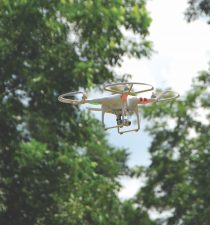
4 Questions to Consider When Introducing New Ag Tech
You have your technology plan—if you don’t, go read West Coast Nut’s “Preparing Your Orchard for Ag Tech”—and you’re ready to dive into some new tech this season to help you make your harvest and management the best and most efficient it has ever been. You’ve done the hard part and chosen which new technology...
Read more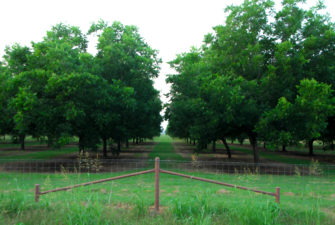
Fifty Years with Texas Pecans, Part II
Many important factors are working together to influence pecans’ profitability in Texas and across the Pecan Belt. Tree spacing, varieties, soil, foliar zinc sprays, nitrogen soil fertilizer, and integrated pest management are some of those factors discussed in Pecan South’s June 2020 issue. Over my 50 years in the pecan industry, I’ve learned that the...
Read more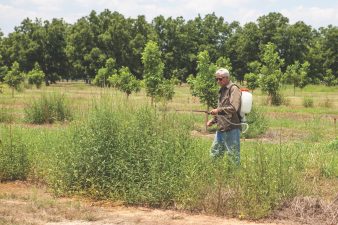
Fifty Years With Texas Pecans
Fifty-one years ago, my wife and I moved to Texas to study pecans for a Ph.D. under Dr. J. Benton Storey, and it has been a great learning experience. I knew nothing about pecans when I arrived but was fortunate to be taught by some of the best pecan leaders. These included Dr. Storey, Bluefford...
Read more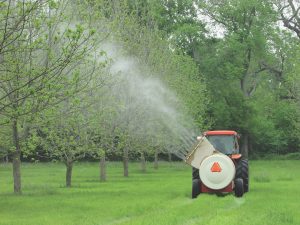
The Story Behind Pecan Zinc Management
Pecan cells and tissue do not elongate or increase in length without zinc. For unknown reasons, pecan tree roots have difficulty in absorbing zinc from the soil, all soils, but especially high pH soils. Pecans growing in high pH soils are dwarfed and never grow to their full potential without foliar zinc sprays. Forty years...
Read more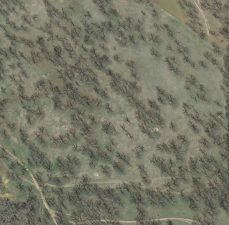
Pecan Tree Thinning: An Essential Task to Maintain Pecan Production
Pecan tree thinning is one of the most challenging operations a pecan grower must accomplish in their orchard’s lifetime. Taking out 50 percent of the trees when they begin to crowd is truly mission impossible. Consequently, many growers, if not all, put off tree thinning and wait year after year until the trees are so...
Read more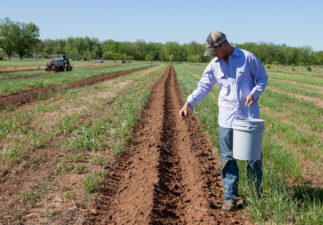
Container versus Bareroot Pecan Trees
Planting pecans is a “rendezvous with death,” according to Professor Fred Brison who wrote the 1974 book Pecan Culture and taught the pecan class at Texas A&M for over 30 years. When we plant a nursery-grown pecan tree in Texas, the chances of death are greater than the chances of survival. All aspects of tree...
Read moreMusings on Pecan Tree Pruning
In the 31 years I served as Extension Pecan Specialist with Texas A&M, the most common question from growers, new and veteran, was how do I prune my pecans. My answer was always the same: don’t prune. It is among the least important jobs in the orchard. Tree spacing, irrigation, applying nitrogen and zinc, IPM,...
Read morePecan Tree Space Management
Pecan orchard design and tree spacing require a series of important decisions for every grower. Once trees are in the ground, growers experience the profit or loss with their original plans and their long-term production or lack of production. I have, from time to time, been entertained by pecan business world investors and developers who...
Read more‘Desirable’: True or False
In early November, we harvested ‘Desirable’ pecans in the Brison Block of the Texas A&M Pecan Orchard on the Brazos River near College Station, Texas. The Brison Block has 18 trees that are over 70 years of age, with trunk diameters of 36 to 48 inches. These are big old trees, yet they produced over...
Read moreThe Curse of Alternative Bearing
Growing, producing, and marketing pecans is a complex process with many tangibles of which we have limited control. Of those, alternate bearing is the most consequential and costly over the orchard’s life. When all production and financial challenges occur, we do what we can and hope for the best; however, alternate bearing never goes away....
Read more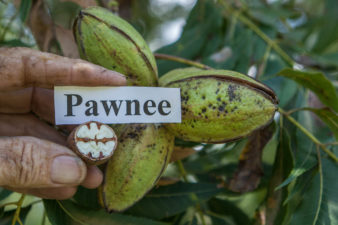
Managing Late-Season Pecan Stress
Much of the Texas pecan crop for late 2019 is under stress due to the lack of rain in August and early September. Our year started with excellent rainfall in the early season for much of the state; however, in July, the rains stopped and the heat increased. And the stress followed soon after. The...
Read more
Late-Season ‘Pawnee’ Challenges for 2019
Our Texas crop for 2019 continues to be a mixed bag. My estimate of 65 million pounds appears to be way too high. Hopefully, Texas can produce more than the estimated 28 million pounds. We know one thing. ‘Pawnee’ looked great in the Texas A&M orchard in early August. Seven of 10 shoot terminals are...
Read more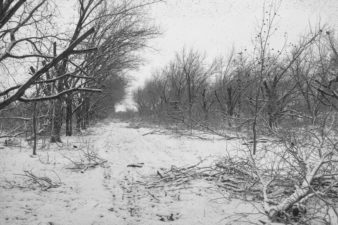
Are Pecan Tree Spacing, Thinning, and Hedging the keys to stable production?
Pecan production is a complex enterprise with at least 16 cultural practices which demand attention and successful execution. Each cultural practice in itself adds to this complexity. One of these practices is preventing tree crowding via a number of alternatives. Growers can plant wide, plant close and remove trees when crowding begins, or plant with...
Read moreOff to a Fast and Rocky Start for 2019
As we escape the springtime challenges of freezes, low nut set, poor pollination, excessive rainfall scab, and a large pecan nut casebearer population, the long hot Texas summer begins for pecans. We had great winter rains with no major freezes. Spring budbreak was early and strong with continued spring rains, and our current pecan foliage...
Read more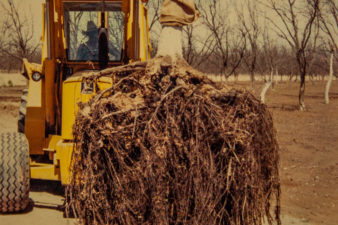
The Mystery of Pecan Roots
At less than 150 years old, the pecan industry is a relatively new commercial crop in the world. Citrus, apples, grapes, and most other fruit crops have been cultivated for profit over a much longer period of time. We know a lot about pecans from a production and technical standpoint. However, there is very little...
Read more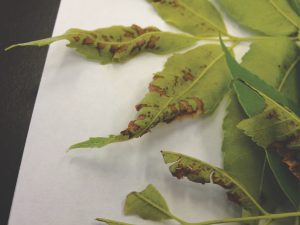
Protect your early season growth with zinc
The 2019 pecan season is about to move into full speed. Our immediate concern is “if” we will have a crop or not. In Texas, our budbreak has been about 7 to 10 days early, so we may be able to count terminals for female flowers soon. Many of us had a big crop last...
Read more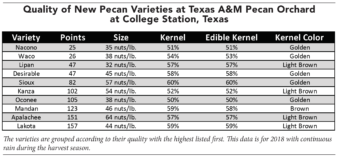
Evaluating the 2018 A&M Pecan Variety Quality
In my 49 years with pecans, my most frequent question has been: “What variety should I plant?” It is a tough question because there are so many variables—climate, soil, irrigation, and management—that influence each variety. Add to those variables, the fact that it takes 15 to 20 years or longer to recognize the potential of...
Read more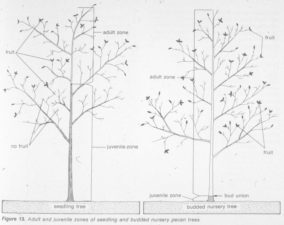
Training Young Pecan Trees is Difficult
To my knowledge and experience, every pecan grower has trouble training their young trees into a central leader tree. In 2017, at the Western Pecan Growers Conference in Las Cruces, New Mexico all five members of the pecan hedging panel said exactly the same thing about their young tree training: “We just let ‘em go.”...
Read more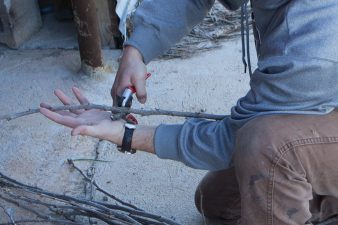
First Step to a Successful Graft? Properly Collecting Pecan Graftwood
Pecans are very difficult to graft. The first success was at Oak Alley Plantation a few miles north of New Orleans in 1846 by a slave gardener known as Antoine. His technique was most likely a cleft graft which was common in propagating other mature fruit trees at that time. If so, he made what...
Read moreEvaluating Pecan Quality by Variety for 2018
The 2018 pecan production season is now complete and harvest is well underway, over, or abandoned. All growers are now wondering how much they will be paid for their hard work and investment in this year’s crop. In an effort to stop China’s unfair trade practices, President Donald Trump made the market season interesting by...
Read moreLate-Season Challenges Threaten 2018 Pecan Quality
The great pecan crop of 2018 may be in trouble. First, there was Hurricane Michael, which went right through the middle of the Georgia pecan industry. Then harvest in Texas was slowed or stopped due to constant rains. Most growers and all buyers are concerned about the quality of the 2018 Central, South, and East...
Read moreRain, Rain, Rain Plagues Texas Growers
Texas A&M Pecan Orchard at the University Brazos River Farm in the 2018 season had set, sized, and filled the largest crop of the last 20 years; but it may be lost from too much rain at harvest. Our June, July, and August were some of the driest months on record, and now, we have...
Read moreUpdates on the Pecan Variety Trial from the Texas A&M University Orchard
The Texas A&M Pecan Orchard at the University Brazos River Farm was first planted by Professor Fred R. Brison in 1948. Today, the Brison Orchard has 11 giant ‘Desirable’ trees in excellent health that have produced good crops each of the last six years. They were originally spaced 50 by 50 feet and have been...
Read moreSeptember Pecan Priorities
Each month we need to determine and accomplish our highest pecan priorities first. What we do in April is totally different from what we do in August, so what are our must do jobs today? In our Texas A&M orchard, we have a bumper crop on 34-year-old Pawnee trees. This year we had to nut...
Read morePreparing for 2019 Pecans, Begins Now
The pecan industry is looking at a very good crop in 2018. In my opinion, Texas should produce over 65 million pounds if no major losses occur. The 2016 Texas crop of 39 million pounds and the 2017 crop of 47 million pounds were less than average, and growers statewide are hoping for better production...
Read moreBefore the Drop, Pecan Crop Estimates for 2018
The 2018 Texas pecan crop at pollination and pecan nut casebearer (PNC) stage looks outstanding. At this moment, it appears that the crop is going to be big, very big, possibly the largest crop ever. However, we can easily lose the entire crop to a number of sources. Every pecan grower in Texas and the...
Read moreThe Things We Know About Nitrogen & the Things We Don’t
As we travel through the pecan passage of time, we learn much and develop a production system for our operation. Young or old, rich or poor, beginner or expert—we all develop the best system for our trees. Since there are many pecan techniques and variables, we should never generalize as to what should or should...
Read more
Uncovering the Mystery of Pecan Pistillate Flowering
Every pecan grower in the entire U.S. will enter their orchards the first week in May to determine if they will have a crop this year. The initiation of female pistillate flowers does not occur until spring of the current season. There is no scientific system for growers to know their crop size before early...
Read more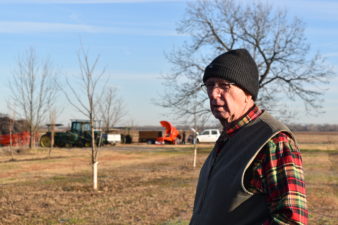
Pecan Management Calendar for 2018
As pecan growers enter the 2018 pecan year, it is good to outline management practices and develop plans for the entire calendar year. Growers can use different types of management—establishment management, low versus moderate versus intensive orchard management, and native grove management. Texas production is in an alternate bearing cycle with 2018 being the “on”...
Read more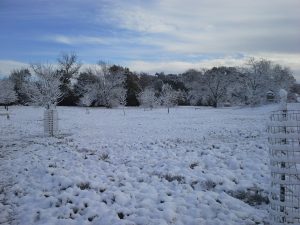
When Freezing Temps Hit, Freeze Damage is a Risk
The pecan industry was hit by a hard freeze the first month of 2018. The most northern orchards received the coldest temperatures, with some less than 10 degrees Fahrenheit. Other orchards in the South experienced temperatures in the teens accompanied by ice, sleet, and snow. How cold must it be before damage occurs? When did the...
Read moreLooking Back and Ahead on the Pecan Journey
When I first joined the A&M Extension Faculty in 1969, Bluefford G. Hancock wanted me to learn pecans and sent me to Hugo Pape in Seguin, Texas once a month for two years. It was the best training one could have received; we learned the same topics taught in school, but this was real life....
Read moreThe Five Fundamentals for Pecan Management
For many Texas growers, the 2017 pecan crop has been difficult to manage. Many have no crop or a short corp. Others have trees with less growth and weak green foliage. However, some growers have their best crop ever. As we look back, we’ll think of what went right or wrong. How do we plan...
Read more“Son, Nitrogen Makes Plants Grow”
This week I told Monte Nesbitt, “Well, it looks like we’re going to have two short crops in a row.” I asked him what he thought. Smiling, he said, “They need a good dose of Ammonium nitrate.” We both laughed because we know one cannot go 15 years without soil-applied nitrogen fertilizer on bearing pecans....
Read more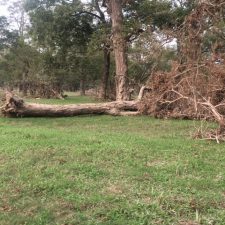
In the Aftermath of Hurricane Harvey, South Texas Growers Assess the Damage
Moving slowly, Hurricane Harvey struck the Texas Gulf Coast over a number of days—Aug. 30 through Sept. 2—encompassing a swath of the state and its neighbors and inundating Southeast Texas with over 48 inches of rain in about four days. This large volume of rain saturated the soil and flooded rivers, creeks, bayous, and streams...
Read morePecans and Pecan People
When the roll is called up yonder all will say, “He was a pecan man” or “that woman really knew pecans.” There are over 1,000 pecan growers in the state of Texas and many more states throughout the South. They work with pecans, they love pecans, and pecans are their life. Profits are nice, but...
Read morePecan Kernel Biochemistry
The pecan is one of the hardest working plants on earth and needs pecan growers to work just as hard to develop kernels properly and fully. The kernel is almost all fat with little sugar or carbohydrates. Complex and arduous, the biochemistry of pecan kernel development is possibly one of the most difficult biological processes...
Read morePecan Challenges and Opportunities—and Those Who Can Solve Them
A couple of months ago a long-time friend said the 2016 pecan harvest and market was the best in history. Wow, that is saying a lot. Can pecan prices remain high and when will the supply catch up with the demand? So what is the future? What is going to be our major issues and...
Read morePecan Grafting Woes
Pecan grafting has never been easy. Olives have been grafted for over 2,000 years, but the first successful pecan graft was not until 1845 by Antoine at Oak Alley Plantation just north of New Orleans. Nurserymen were able to whip graft below ground in the early 1900s and the rough bark patch bud was used...
Read morePecan Chilling and Delayed Bud Break
The 2016-2017 winter at College Station, Texas was the warmest in the last 45 years. According to the U.S. Weather Service via Underground Weather and “Get Chill Hours” on the web, we received only 368 hours of winter chilling below 45 degrees Fahrenheit from Nov. 1, 2016 to Feb. 28, 2017. From 1969 to 1974,...
Read moreHow to Prune to Hedge
Congratulations to the Western Pecan Growers Association for an outstanding conference March 5-7. One of the main topics was a grower panel on hedging led by Mike Kilby, and it was very good. Pecan hedging has been with us for a long time, or at least since growers began planting more than 27 trees per...
Read more2017 Pecan Calendar for Texas
As pecan growers enter the 2017 pecan year it is good to outline management practices and develop plans. Growers can use different types of management: establishment management, low vs moderate vs intensive orchard management, and native grove management. Texas production is in an alternate bearing cycle with 2017 being the “on” year, which means two...
Read moreOld Pecan Varieties
Every new pecan grower wants to establish an orchard as fast as possible in order to establish a cash flow and pay off the land, establishment, development and production costs as soon as possible. Important factors in this new orchard process are ideal climate, soil, salt-free irrigation water, management, labor, money, available time, knowledge, and...
Read morePecan Sale Price – What is too low?
This month I have had 4 people indicate our price of $10 per pound for shelled pecans is too low. Each grower has to determine a price that works for his orchard. For many or most, the goal is to is sell field-cleaned in-shell nuts with a good percent kernel for the variety. The no-marketing-worry...
Read morePecan Harvest and Rain
We are up and running with our 2016 harvest at the A&M pecan orchard. Most Texas growers outside the far west are through harvesting their ‘Pawnee’ and are now picking ‘Desirables.’ The results are too early to tell; it has been a year of rain, no rain, and rain. We had great rains in the...
Read more
Tribute to Mark Salopek
My lifelong friend and pecan hero, Mark Salopek of Las Cruces, New Mexico, passed away on Aug. 21 after a hard fight with cancer. We were students together at Texas A&M University in 1969-70 when his father called him home to make their pecan deal work. He and his brothers James and Ben returned home...
Read moreAugust is Pecan “D-Day”
The Texas pecan crop for 2016 will be made or lost in August. Our year started with a good, not great crop statewide. There were excessive spring rains and the trees looked great with the finest green foliage on record. There was enough rain and humidity for pecan scab to set in on most varieties....
Read morePecans—Over-Cropped and Under-Watered
The recent TPGA meetings in San Marcos, Texas were great and we learned how the Texas crop is shaping up for 2016. The crop from Brownwood to El Paso looks good and could be 15 to 20 million pounds. The rest of the state has 35 million bringing the best guess at this time to...
Read moreRain Issues for Texas
The Texas A&M Pecan Orchard received over 12 inches of rain in May 2016, making it the second highest rainfall May in history for the area. The weatherman says we have 4 days with more than 50 percent chance of rain the first week of June, so more water may be on the way. The...
Read moreTexas A&M Pecan Orchard History
The first Texas A&M pecan orchard was established in the early 1900s by E.J. Kyle, then Professor of Horticulture and instructor of the HORT 418 Pecan Class. The trees were at the northwest corner of campus at the intersection of FM 60 and Union Pacific Railroad. The planting remained until removal for construction of the...
Read moreTraining Young Pecan Trees
Every pecan grower wants to establish a new orchard as fast as possible with the trees trained as a central leader with the first scaffold limbs at least 5 feet above the ground. However, many fail to understand training or pruning young trees is not job one. More important needs are good soil, salt-free irrigation...
Read moreRapid Pecan Establishment
Planting pecan trees is not an easy task. In anticipation of a beautiful mature orchard, one can hope for the best but end up with dead trees or trees that refuse to grow. This idea is not original—Professor Fred Brison called planting pecans, “a rendezvous with death”. During the last five years we have established 14...
Read morePecans Need Water
Texas is currently experiencing a very warm winter with limited rain. It is not time to irrigate, but we worry about the coming season if this drought continues. If one were to ask, what affect pecan profits most? — some would say rain. Rainfall is the perfect irrigation with slow delivery, good infiltration into the...
Read morePecan Harvest 2015 at Texas A&M
We have completed harvesting, processing and retailing 60 percent of our 2015 pecan crop at the Texas A&M Orchard. Our current 2015 crop was a surprise. In the November 2014 Pecan South, we reported an outstanding very large 2014 crop and suggested a sizable 2015 crop would be unlikely. However, this year’s crop was even...
Read morePecan Quality Cuts Yield in 2015
Our 2015 issues continue at the Texas A&M pecan orchard as we are now in an extended rain period. Our year started with highest ever spring rains, then the rain stopped and we experienced a long hot dry period, which has reduced our yield. Many varieties failed to bear because 2015 was our “off” year....
Read morePecan Heaven to Hell in 2015
Our 2015 crop at the Texas A&M orchard is in dire stress and needs water. We have/had a great crop on ‘Pawnee’, ‘Desirable’, ‘Kanza’ and some USDA hybrids. All other varieties have a zero crop. Our season started great with more spring rain than ever. The early season foliage was great. We learned how beneficial...
Read morePecan Harvest Challenge for 2015
The Texas A&M pecan harvest for 2015 is upon us and there are many concerns as to how the crop will develop from now until Dec. 7 when the nuts are in the barn and ready to sell. The year started out great with rain, lots of rain; the most spring rainfall in 50 years....
Read morePecan Scab Questions
Texas is currently experiencing a major drought and heat wave following the wettest April and May on record. Our very wet spring set the stage for a major pecan scab year. I am not and have not been paid to be a plant pathologist; however, I study and worry about scab. I have experienced pecan...
Read morePecan Laws
As pecan growers, our lives, jobs and future are all impacted by laws, either civil or common. Comments here are not published as fact or law, but rather for consideration. Alternate Bearing Law of 1528: Cabeza de Vaca established that pecan trees bear every other year. A big crop is followed by a low crop...
Read more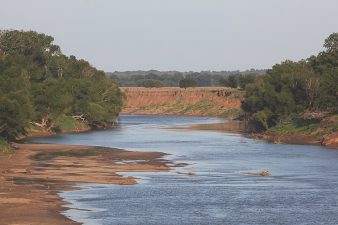
Texas Big Flood Followed by Drought
Texas agriculture has battled soil moisture since the first orchards were planted in the early 1900s. As E.E. Risien said, the 3 most important things pecans need are water, water, water. In 2011, Texas growers received only 2 rains while this April and May the state received record rainfall. The entire state of Texas was...
Read morePecan Orchard Establishment
Planting seed in place. Pecan orchards are difficult to establish by planting seed because it requires individual tree care for tree selection, irrigation, weed control and unwanted tree removal. All of which occurs over a long three to five year period of time. Though seemingly less costly, it is, however, the most expensive system for...
Read more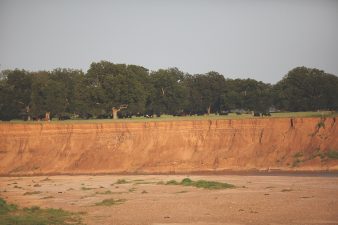
Pecan Soil and Production Potential
Many factors influence production and profitability but few or none are more important than the soil on which pecans are grown. We always say, “Pecans need deep, well-drained soil;” but the question is how deep and how well drained? Irrigation is important, but the water delivery and rate depends on the soil. Soil and water...
Read moreAnnual Pecan Calendar
As pecan growers enter the 2015 pecan year it is good to outline management practices and develop plans. Growers can use different types of management: establishment management, low versus moderate versus intensive orchard management, and native grove management. Texas production is in an alternate-bearing cycle with 2015 being an “off” year. Our rainfall last season...
Read morePecan Highs and Lows for TAMU in 2014
The Texas A&M pecan orchard had a great year in 2014; but it was not without issues and problems. The harvest was great with 17 acres producing 13,050 pounds of nuts, which were retailed as kernel halves or large pieces and/or chocolate covered halves for $43,500. This was our best season since 2009, hopefully, we...
Read morePecan Quality and Price
Way back in November 1969, Bluefford Handcock and I judged the Menard County Pecan Show with Duncan Wilson and Sam Kuykendall. After the show, Duncan gave Bluefford a free deer hunt on the ranch, but he did not get his big buck that day. Mr. Hancock feels the sights were off on Duncan’s rifle. The...
Read morePecan Harvest 2014 at A&M
The Texas pecan harvest for 2014 is well underway except for the far West. Last winter was the coldest sustained weather in Texas without a warm “Indian Summer” in my 44 years at Texas A&M. At College Station, we received more than 900 hours of winter chilling below 45 degrees F from October to March....
Read morePecan harvest woes and uncertainty
Many years ago, a long-time pecan grower told me: the entire season is practice, the game begins with harvest. He was correct. Harvest is everything – good, bad and unknown. The 2014 first ‘Pawnee’ harvest at the Texas A&M orchard is now complete and the nuts are at the sheller. Our Oct. 2 harvest was...
Read morePecan harvest 2014
Harvest time is here, I hope we are ready. The Texas A&M orchard ‘Pawnees’ should be ready for harvest on Sept. 27 if all goes well. We have about 1 percent of the shucks open with total separation of the nut with a totally brown shell. A few nuts are 95 percent filled because some...
Read moreAugust/September pecan tree stress
Our 2014 crop at the A&M orchard looks good and we are scared to death something will go wrong. August and September is stress management time. We are trying to manage the trees to reduce stress because we have to fill the kernels; we have to have a return crop next spring; we have to...
Read morePecan nut thinning is now!
Texas has a great pecan crop for 2014. All trees not hit by the late winter freeze are loaded. In addition, we have had the best late spring and summer rains in some areas with very little scab. Most varieties at the Texas A&M pecan orchard are loaded. We had 5 major rains of 3...
Read morePecan Records and Pesticides
I hate to keep records; I would rather go to the orchard and do something rather than record data. However, every night I log all the significant pecan activity in my desk diary and have been doing so for many years. The information though seemingly unimportant at the time could be valuable in the future....
Read morePecan post-freeze management
Much of the western pecan belt in West Texas, Southeast New Mexico, and Southwest Oklahoma was hit hard by the late season freeze of April 15, 2014. Temperatures as low as 21 degrees F were recorded, and damage was obtained to some trees with only 28 degrees F. Pecans are known for being the last...
Read more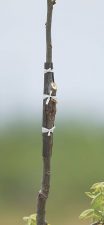
Pecan Grafting Tips
Olive grafting is 2,000+ years old as described in the Bible, and pecan grafting began at Oak Alley Plantation just north of New Orleans in 1855 or so. Grafting in pecans is not an easy process, it is difficult; especially in the arid Southwest. Gulf Coast or southeastern growers and nurserymen can use a wide...
Read morePecans and cold weather
The winter of 2013-2014 has been the coldest sustained weather in Texas without a warm “Indian Summer” in my 43 years at Texas A&M. At College Station, we have received more than 900 hours of winter chilling requirement below 45 degrees F from October to this date. In addition to the chilling, there have been...
Read more2014 Pecan Calendar For Texas
As pecan growers enter the 2014 pecan year, it is good to outline management practices and develop plans. Growers can use different types of management: establishment management, low vs. moderate vs. intensive orchard management, and native grove management. Texas production is in an alternate-bearing cycle with 2014 being the “on” year following the short 2013...
Read moreLooking Back On 2013 Pecans
Our 2013 season was marked by both high and low experiences. Our group of students of the last four years was happy with the good growth and development for the Texas A&M Orchard at the TPGA Conference. It has been a hard but rewarding experience for all of us and we were happy to share...
Read morePecan Rain Problems
The 2013 Texas pecan harvest started out late, and then came the rains, which made it even later. Some growers may not harvest due to rain. On the other hand, rain is the finest irrigation a pecan orchard can obtain. E.E. Risen, the father of pecan production at San Saba in the late 1800s said...
Read moreOld Pecan Varieties in Texas
There are over 1,000 varieties of pecans; but how many are “the best”? In Texas, there are only a very few: ‘Western’, ‘Desirable’, ‘Pawnee’, maybe ‘Caddo’, ‘Sioux’ and ‘Kanza’. In 2011, I wrote an article on the varieties THAT have potential, so we will not go there here. This winter, we face the hard task...
Read morePecan harvest crows, hogs and drought
Here we are at D Day for our ‘Pawnee’ harvest and the crows have moved in by the hundreds. They are always a problem when the crop is short statewide. Last year we had only a few crows because there were pecans everywhere — not true this year. We have the all new Bird Guard...
Read moreTexas Pecan Show Down
We all know August and September are the make it or break it time in pecans. This high-stress period is an old time gun fight — we live or die in 45 days. So much must be done and if not, we can lose the total crop. The key is to have pecans and keep...
Read more
Roundup-Resistant Pigweed
Pecan industry: we have a problem. Since our first trials with Roundup (glyphosate) in 1973, we have had a near miracle cure for weed control in pecans. The happy days are over. We now have a rapidly growing, tall weed with a base over 1 inch in diameter that is both hard and fiber-filled. One...
Read more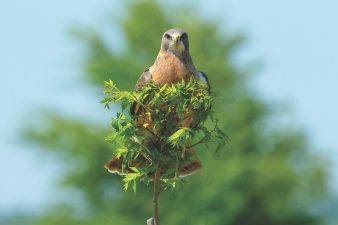
Pecans Grafting Tips, Hints and Failure
Monte Nesbitt and I are grafting 14 acres of young ‘Mohawk’ seedlings with the latest USDA varieties and, in so doing, developing a research orchard for future use. We had good luck last year and this year. In 2013 we started late due to the cool weather and slow bud break, but had good luck...
Read moreMany pecan questions remain
Many have grown, worked and studied pecans for 100 years with change coming with each generation. In the last 40 years, a dramatic change has occurred yet many questions continue and new production systems will come. Here are some of our major concerns. Alternate bearing has and will continue to bring unstable prices and profits...
Read moreLet’s get to work!
The 2012 crop finished in a mess and we know the 2013 crop is going to be light – but we have to get to work, whether we like it or not. We must remember our main goal in pecan orchard management is keeping the trees healthy. We should have our first Roundup treatment behind...
Read moreYoung pecan tree training
The focus for 2013 at the Texas A&M pecan orchard will be young tree training. When I came to Texas in 1969, pecan trees were trained entirely different from how we do it today. In the old days, spacing was wide with scaffold limbs beginning only 4 to 6 feet from the ground. The old...
Read morePecan Price is Complex
Current pecan prices paid to growers are terrible. So, the question is why? The 2012 pecan harvest was big – bigger than expected, and it was on an “off” year when production was to be low. I estimated the crop to be 45 million for Texas at the Louisiana meetings and I do not know...
Read morePecan investments
For the first time in 120 years, pecans are priced high enough for consideration as a sound investment. Interest in pecan orchards is at an all-time high. From the mid-1960s until the late 1990s, investors purchased pecan orchards because of great IRS tax advantages. One could purchase a bearing orchard, then use tax credits and...
Read morePecan Grading on a Bad Year
Wow, what a year for pecans. Great start with a big crop in an “off” year and good rain to get the season going. In July at the Texas Pecan Growers conference we all knew the crop was big and we had to shake. Nut thinning for reducing crop size in July and early August...
Read moreThe ‘Desirable’ Pecan
Three Texas pecan buyers have stated the 2012 crop is “the year of ‘Desirable’.” It has produced top quality nuts across the river region from Victoria north to Waco. The Texas A&M pecan orchard ‘Desirables’ are the best ever and superior to all other varieties this year. We have 13 large 75-year-old ‘Desirable’ trees, 40...
Read morePecan Pralines
Each holiday season I make many batches of pralines for friends, parties, and folks who need a little lift. This did not just happen — it took me about 4 years to learn how to make authentic Louisiana or New Orleans Pralines. They are sometimes called Creamy Pralines or Caramel Pralines. So, what makes these...
Read moreDrought and pecan tree death
The 2-5 year drought in Texas has taught us many lessons. We have some orchards with 40 percent dead pecan trees, while others are loaded and looking good. So, why do some trees die while others do not? Without leaving the Texas A&M orchard we have some trees that are dead or near dead while...
Read morePecan Monster Stress
The river region of Texas from San Antonio to Texarkana has a monster crop. Improved and native trees are loaded. Limb breakage is a major problem. All loaded trees are in stress. We are dry and the trees are loaded – we have a problem. Some growers shook back in July and that helped a...
Read moreTexas pecans: shake and make
We just completed shaking off 400 pounds per acre of green, waterstage ‘Pawnee’ pecans in the A&M Storey block. The trees were overloaded with clusters of 3 to 5 nuts on 10 of 10 shoots. Our crop was good last year, but not great enough to shake. This was the “on” year and the trees...
Read moreGreat Crop Plans and Mike Luke
The 2012 crop continues to look great in Texas. We have had sufficient winter chilling, and spring rains have been perfect, exceeding the entire 2011 season. The pecan nut casebearer emergence exploded earlier than normal and with record male moth trap catches; then the females crashed with few or no eggs and few or no...
Read moreGreat start demands work
The 2012 Texas pecan flowering looks great. Most trees native and improved have a strong flower crop. Budbreak and flowering look to be 10 to 14 days ahead of normal. There has also been the earliest ever emergence of pecan nut casebearer (PNC). At least three things contribute to our big crop; the 2010 “off”...
Read morePecan Grafting and Varieties
The new Texas A&M pecan planting will be in the fourth leaf this spring and we will begin grafting in early April. Our plan is to use the Texas Method Inlay Bark Graft on the trees with a trunk diameter larger than 2 inches and the Four Flap (Banana Graft) Graft on all the smaller...
Read morePecan stress symptoms
Not all pecan trees are healthy. Many pecan orchards have trees experiencing stress symptoms and some have hidden or non-visible hunger signs. January and February are good times to evaluate tree health as one can observe dormant shoots throughout the tree. The best way is to look at shoot length in the top of the...
Read more2012 Pecan Calendar for Texas
As pecan growers enter the 2012 pecan year, it is good to outline management practices that may need to be used and develop plans. The 2011 pecan prices were the highest ever paid and growers are excited about the future. The 2011 year was terrible for Texas growers, but good prices helped ease the pain....
Read morePecan Investments
For the first time in 120 years, pecans are priced high enough for consideration as a sound investment. Interest in pecan orchards is at an all-time high. From the mid-1960s until the late 1990s, investors purchased pecan orchards because of great IRS tax advantages. One could purchase a bearing orchard, then use tax credits and...
Read morePecan Fall Foliage – Is It the Key?
Pecan trees across the upper South are currently showing a beautiful golden yellow leaf color. This is because the green chlorophyll has broken down within the cells and leaves. It makes us wonder; what is going on inside the leaves of pecans? The late great pecan grower and mentor of many in the river region...
Read moreTop 10 “Bad” List for Pecans
For many years I watched David Letterman and had a lot of laughs at someone’s expense; but as of late I’ve stopped. Life is too short to hurt anyone, but I will hand it to Letterman, his Top 10 list is interesting and it causes us to think. Here is my current, Bottom 10 list...
Read moreTexas Pecan Drought Impact
Everyone in the pecan industry knows Texas is currently experiencing a 20-month drought. Pecans are in bad shape. If there ever was a good year for no pecans, 2011 is it. Trees are stressed to the limit and a good crop could or would kill the trees. The following are some of the signs the...
Read moreTexas Pecan Drought Continues
All of Texas agriculture, landscape horticulture, and home yards are in trouble. We have had only two rains in 2011 and last year was a dry year. As one drives across the state, the severity of our statewide drought is obvious. Pastures are grazed to the soil or dead gray, ponds are dry and cattle...
Read moreTexas Pecan Numbers
I like numbers. Some people hate numbers. And don’t forget, numbers can be wrong, or they simply lie. Here are a few Texas Pecan Numbers, maybe right, probably wrong. There are 600,000 to 1,000,000 acres of native pecan trees in Texas, and the number of managed natives is unknown. The finest native groves average less...
Read moreBig Pecan Drop in 2011
The Texas pecan crop for 2011 appears to be in a nose dive. I understand there are some orchards throughout the state with a good crop. I do not know the crop situation in far West Texas. I do know the south-central river region from Waco to the Gulf is in bad shape. Some growers...
Read morePush Young Trees in Early Summer
Pecan orchard establishment can be slow or fast depending on soil type, depth, irrigation, weed control, zinc sprays, nitrogen fertilization and pruning. With the increased interest in pecans as a cash crop, there are many new plantings. Not all trees will grow; some will actually die while others will make tremendous growth. The main idea...
Read moreHello, Georgia
After 42 years, I finally attended a Georgia Pecan Growers Meeting last month. I knew it was different right off the bat because it was raining cats and dogs. Texas pecans are in a major drought. It has rained only once at College Station in the last 10 months. Our Horticulture Department constructed an irrigation...
Read morePecan Planting Success
Pecan Professor Fred R. Brison said, “Planting a pecan tree is a rendezvous with death.” Early in my career during the pecan planting hay day of the early 1970s we saw many orchards go in overnight which failed to grow and, after a couple of years, the trees died. We cannot stick the tree in...
Read more2011 Pecan Calendar for Texas
As pecan growers enter the 2011 pecan year, it is good to outline management practices which may need to be used and develop plans. The 2010 pecan prices were the highest ever paid and growers are excited about the short and long term future. The 2010 season was an “off” year, but prices changed the season....
Read moreOld & New Pecan Varieties for College Station
Last week we collected our pecan graftwood for use in April grafting. We are using stump suckers to grow graftwood for next year. In 2012 we will be grafting 14 acres of 3-year-old seedlings. It is our plan to have strong 2-inch trees and we will place the grafts 4 to 5 feet from the...
Read moreTired pecans and orchard decline
For years growers have been talking or asking why their trees are in decline. For the last two years, I have been working with three Texas A&M orchards that were definitely in decline. It is not a good time for decline because the pecan industry is at a wonderful point in time; the world has...
Read moreGood and Bad from 2010
The 2010 pecan year at the Texas A&M pecan orchard had some good and not so good results. We finished removing trees in the Storey block with a 50-by-50 spacing for 25-year-old trees. The stumps did not all die, so we still have to take out stumps for about 30 trees. We had a good...
Read moreDo stink bugs love ‘Pawnee’?
The Storey block in the Texas A&M orchard had a good ‘Pawnee’ crop in 2010 and it follows the good crop of last year. The set on outside, well-spaced trees was so great we decided to shake in late July to help reduce stress, improve kernel filling, and hopefully get a third crop in a...
Read moreHurricane Hermine Pecan Shake Down
September crop outlook for Texas looks good, and it is definitely not an “off “year. As the nuts and clusters began to fill out, we could see the crop will be bigger than an average “off” year harvest of 40 million pounds. We had a dry summer for low scab conditions and scattered rain for...
Read moreTexas Pecan Checklist
There are a number of grower-accepted practices for pecans —for natives, intensively managed orchards, standard orchards, sustainable orchards, and abandoned orchards. These practices can be used from time to time, regularly, or as a “must do” practice every year. Practices affect pecan alternate bearing, tree health, production, kernel quality and profits. A grower should want...
Read moreNitrogen is #3 in Jobs to Do
In the production of pecans as a commercial crop, some things are constant and we cannot do much about them, such as soil depth, soil drainage, money available for management, time available with other jobs, etc. The big four jobs are water, weeds, nitrogen and zinc sprays. Here we talk about nitrogen. I am concerned...
Read moreNo. 1: Pecans Need Water
We all know pecans need deep, well-drained soil, a warm climate, financing and good management. But when it comes to what we can do, irrigation is number 1. Nothing we do in the orchard affects profit more than irrigation. For years or decades, we have said pecans need one-acre-inch of water every week from April...
Read moreBasic Four for the Pecan
Pecan growing is not a simple task. For trees to grow and bear quality nuts, over 100 different challenges must go right. Pecan growers know one needs a warm climate, deep well-drained soil, a lot of money, the desire to grow pecans, and good management. There are 4 absolutely essential management tasks that we must...
Read moreCastro Provided Unequaled Contribution to Mexican Industry
RUBEN CASTRO MEDINA Torreon, Coahuila, Mexico 1941 – 2010 Ing. Ruben Castro Medina, long-time Director of CONAFRUT for all of Mexico, passed away on May 8, 2010. Few individuals have contributed more to the culture of pecans than Ruben Castro. In the 1970s and ‘80s, Castro, as Director of CONAFRUT/Pecans in northern Mexico, supervised over...
Read moreJ. Benton Storey, 1928-2010
Benton Storey in 1957 began a 45-year career with the Department of Horticultural Sciences at Texas A&M University in College Station, Texas, where he taught HORT 418 “Pecan Culture” from 1960 to 2002. He was a major advisor for 52 advanced degree students in various components of pecan science. More professional pecan scientists trained under...
Read moreTree Space Management In Pecans
When pecan trees crowd they should be cut down, attached to a tractor with a chain, pulled to an open space, cut into small pieces, piled, allowed to dry for one year, and burned. This is a simple operation. A team of 3 men can thin one acre per day if trunks are less than...
Read more2010 Pecan Calendar For Texas
As pecan growers enter the 2010 pecan year, it is good to outline management practices that may need to be used and develop plans. The 2007, 2008 and 2009 early markets were less than ideal as far as prices to grower. The 2009 crop started out great, but 4 months of drought followed by way...
Read morePecan Crash of 2009
Congratulations to all pecan growers who had a great crop on a big “on” year. Most of us did not fare so well. We had a terrible year in 2008 with a short crop and terrible prices, so we were all expecting this to be a comeback year. The crop looked great throughout much of...
Read more